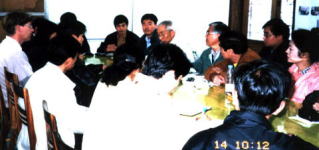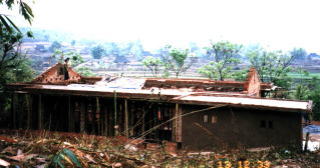NO.176-4
Visit to the Construction Site for Terakoya Schools in Vietnam
Shigeo Tajima Advisor, Meguro UNESCO Association
Time and Purpose
For two weeks from March 9 to 24, I made a research trip to Vietnam at
the request of The National Federation of UNESO Associations in Japan;
to visit the construction site for Terakoya schools. (Learning Centers)
At the school, which is scheduled to open this summer, not only reading
and writing but also agriculture will be taught. The other purpose of
my trip was to find out for the teachers what and how to teach in this
agriculture class. Discussions were held among more than ten people including
Mr. Okukawa, local representative of the project, two Japanese experts,
one in agriculture and the other in bee culture, local government representative,
representative and experts from agricultural guidance organizations. We
came up with a conclusion.
Location of Terakoya Schools
A total of 40 Terakoya schools are planned to be constructed in Toa Tua
and Phong Tho districts of Lai Chau Province situated close to Laos and
China…northwestern part of Vietnam. An hour flight on propeller-driven
aircraft from Hanoi will take you to Dien Bien Phu, capital of Lai Chau
Province. Another 6-hour drive on car will lead you to Tua Chua District. It
is planned to build a Terakoya school at each of 11 villages in the District. Also
it is planned to build a Terakoya school at each of 18 villages in Phong
Tho District, 8-hour drive from Dien Bien Phu. The number of schools here
under the plan is 29.
These car drives are not on highway or speedway by any means. You must
climb up and down on a mountain road along a river turning right and left
sharply. I tried to count the number of passes we crossed but after 7
I gave up because it seemed countless. The difficult access to these villagesprobably has caused the lowest rate in literacy.
 Construction Conditions of Terakoya Schools
Construction Conditions of Terakoya Schools The progress conditions of 10 schools, which I visited, were more or
less the same, because they probably started the same time. Each school,
occupying not very large land space, has 3 classrooms, each of which accommodates
20 to 30 students. I was pleased to see that foundations of the buildings
were completed already and solid brick walls were getting built. Everywhere
I went, I saw several workers were laying bricks for the walls or raising
the frameworks. Toilet rooms and drinking fountains were already completed
outside the main buildings. They were expecting the final completion in
April.
Contents and Materials of Teaching
As to the general classes of reading and writing the Vietnam government
had prepared both the contents and materials. An expert of adult education
is already working as staff at Mr. Okukawa’s office, so the preparation
was 80 to 90% finished. As to the agriculture-related teaching, which
occupies 60% of the total educational operation, however, hardly any preparation
was done. One relief was that the local agricultural extension offices
with the cooperation of a Dutch expert sent from a German NGO, were trying
to introduce various kinds of crops as test samples and some farmers were
willing to try them. Of course, some problems were immediately found,
which called for improvement. But the important thing is that both the
leaders and the farmers seem to understand the need or the basis for agricultural
improvement and development. I could therefore make an optimistic forecast
that we may be able to expect fairly early results.
When we discussed what kind of crops would be promising and profitable,
tea, banana, mushroom, and beekeeping were proposed. After making on-sight
inspection, we came to a conclusion that beekeeping would bring the result
most certainly and that we should put the emphasis on beekeeping in the
agriculture classes of Terakoya schools.
Last but not the Least
Last but not the least, I would like to talk about Mr. Okukawa, who is
the head of Terakoya project office in Vietnam. Mr. Hiroshi Okukawa,
31 years old, working busily as a UNESCO representative, is negotiating
with leaders of the Vietnamese government at different levels in stately
manner just like first class experts of the international organizations. Many
local leaders, who are calling him by his first name Hiroshi, love him
and staff of his office respect him deeply. I have seen many Japanese
youths working overseas and he ranks the top among them in terms of leadership.
To Young People
I highly recommend young people, especially those of Meguro UNESCO Association,
to learn from Mr. Okukawa what an international cooperation for development
is and what an UNESCO spirit will be when put into practice. (April 29,
2001)
In 2000 Meguro UNESCO Association gave donation of 450,000 Yen for constructing
Terakoya schools in Lai Chau Province, which is carried jointly by The
National Federation of UNESCO Associations in Japan and The Japan International
Cooperation Agency (JICA). (Refer to 2000 Financial Report)
 Construction Conditions of Terakoya Schools
Construction Conditions of Terakoya Schools Construction Conditions of Terakoya Schools
Construction Conditions of Terakoya Schools